
+1 (312)439-2098
- Home
- Solutions
- Residential Buildings
- Voltage Monitoring with HRN Relays: Protection Beyond the Basics
Voltage Monitoring with HRN Relays: Protection Beyond the Basics
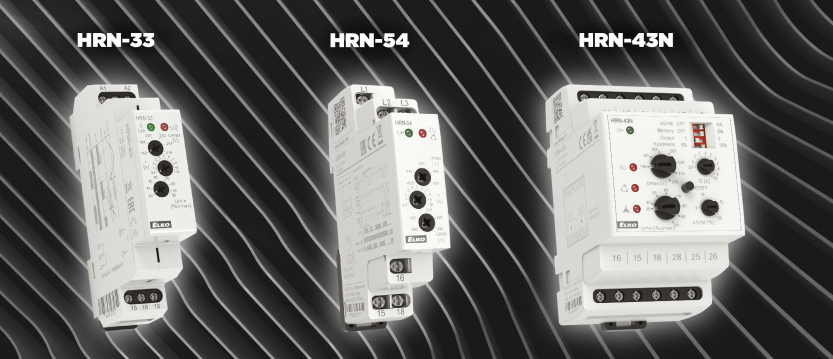
Today’s homes and workplaces are full of sophisticated electronics—smart appliances, microcontroller-based systems, and sensitive equipment. Yet many of these devices remain vulnerable to basic electrical disturbances. A sudden overvoltage, undervoltage, or even an incorrectly sequenced three-phase connection can lead to malfunction, damage, or complete failure.
To reduce these risks, it’s essential to implement protection beyond basic surge protection. This article explores how HRN voltage monitoring relays can help—and how combining them with time relays can further improve system stability and resilience.
Why Monitoring Matters
One of the lesser-considered issues in electronic systems is too-quick reactivation after a shutdown. A brief power outage or voltage drop may be enough to reset a system, but if power returns too quickly, the device may not have time to properly initialize.
Microcontrollers rely on a stable “RESET” process during startup. If the supply voltage hasn’t fully dropped or internal capacitors haven’t discharged, the device might restart in an unstable state—leading to unpredictable behavior or even permanent failure.
This is not limited to electronics. Refrigeration compressors and air conditioning units can suffer mechanical damage if restarted before pressure has equalized. While manufacturers include some protection, it’s not always sufficient.
HRN Relays: Monitoring Critical Parameters
ELKO EP’s HRN series of voltage monitoring relays are designed to detect and respond to key electrical conditions:
- Overvoltage and undervoltage
- Phase loss
- Incorrect phase sequence
- Phase asymmetry
Most HRN devices include configurable over/undervoltage thresholds and delay timers to avoid false triggers from momentary disturbances. Depending on the model, they may be powered either externally or directly from the monitored supply. In normal operation, the relay output is energized (closed); it deactivates when a fault is detected.
An exception is the HRN-35, which works in reverse: it activates its relay only when a fault is present, making it ideal for alarms or signaling.
The Role of Timing in Protection
While HRN relays protect against voltage deviations, they do not prevent systems from restarting too quickly. That’s because they rely on hysteresis, which is not time-based—it simply requires that voltage levels stabilize within a predefined percentage (e.g., 5% or 10%).
To protect against fast reactivation, two solutions exist:
1. Use HRN models with a “MEMORY” function
- Single-phase: HRN-41, HRN-42
- Three-phase: HRN-43
These require a manual RESET after a fault—ideal when you want deliberate reactivation.
2. Add a time relay to the output
This automatic solution delays power restoration even after the voltage stabilizes, allowing devices time to reset or decompress internally.
Single-Phase Example with Time Relay
In Figure 1, a single-phase HRN-33 is combined with a CRM-91H time relay.
- HRN-33 monitors the supply and energizes its output relay only when voltage remains within the Umin–Umax window.
- If a fault persists beyond the configured delay, the relay deactivates.
- Once conditions normalize, the relay re-energizes with hysteresis.
- The CRM-91H, configured with function “a” (delay-on start), then waits a specified time before reapplying power to the protected load.
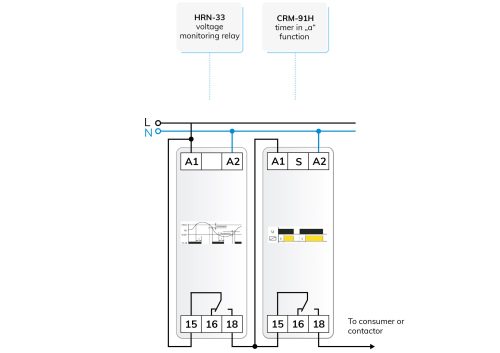
The timing should suit the connected device. For most electronics, 30–90 seconds is a safe window. Refrigerators and compressors may require 5–30 minutes, depending on the design.
Three-Phase Example with Time Relay
Figure 2 shows a similar setup using the HRN-54 or HRN-54N for three-phase networks. These models monitor:
- Over/undervoltage
- Phase loss
- Phase asymmetry
(HRN-54N also monitors neutral)
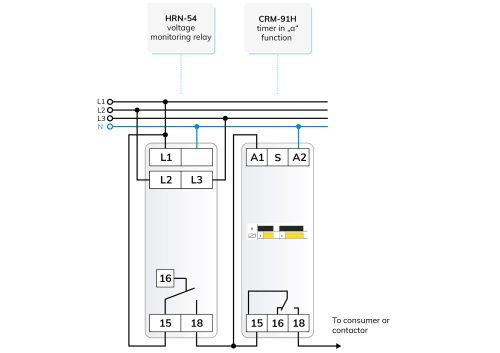
The logic is the same as in the single-phase case: a time delay is introduced after voltage returns to normal.
Multi-Relay HRN Devices and Selective Control
The HRN-43/230V and HRN-43N/230V three-phase monitors include two relay outputs, allowing finer control:
- Output switch in position 2:
- One relay signals overvoltage
- The other signals undervoltage
- Output switch in position 1:
- Both relays activate in parallel for any fault.
Figure 3 illustrates using the outputs in parallel to trigger a single time delay—suitable when all voltage faults are treated equally.
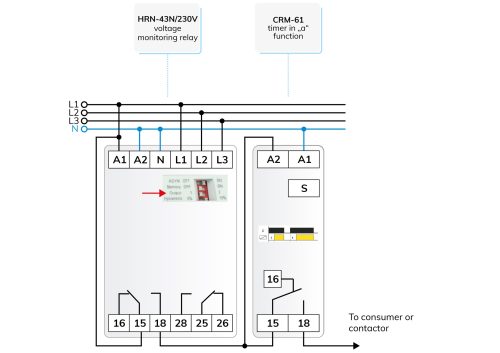
Figure 4 shows separate handling of overvoltage and undervoltage, with a VS116K auxiliary relay used to combine the two signals using “AND” logic:
- The time relay activates only when no undervoltage is detected and no overvoltage is detected.
- This ensures power is restored only when all conditions are normal.
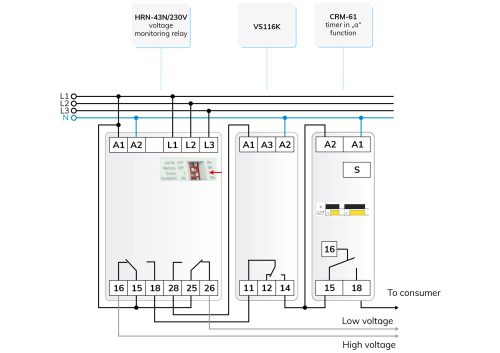
Final Notes
HRN voltage monitoring relays provide essential protection against voltage irregularities, and by combining them with time relays, you can prevent premature reactivation—a common source of equipment failure.
All circuits in this article are provided as conceptual examples. While they are tested under controlled conditions, live implementations may vary. It is the installer’s responsibility to validate functionality and adapt the designs as needed.
Reminder: Wire colors shown in diagrams are illustrative and may not reflect standard electrical conventions.
Didn't find what you were looking for?
Headquarters
1150 NW 72nd Ave, Tower I,
Suite 455 #9226, Miami, FL 33126
Tech Support
+1 (312)439-2098
techsupport@elkoepna.com
General Contact
+1 (608)746-1332
info@elkoepna.com
Central Warehouse
7200 Intermodal Dr, Louisville, KY 40258